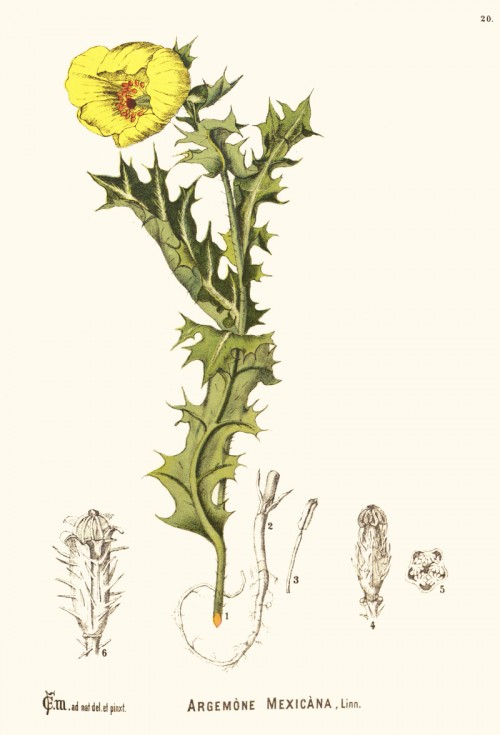Argemone mexicana L. - Papaveraceae - prickly poppy, Mexican poppy, Mexikanischer Stachelmohn, Mexikanische Distel
Annual herb to 1m high, native to central America, cultivated for centuries, naturalized in many tropical and subtropical regions; plant with bright yellow latex; stems, leaves and sepals spiny; leaves usually blotched with paler green; flowers closely subtended by the upper leaves, yellow or cream, 3-6 cm wide.
„A single sample of authenticated A. mexicana seed contained dihydrosanguinarine as the major alkaloid with minor amounts of sanguinarine and berberine, in agreement with earlier studies. Dihydrosanguinarine and dihydrochelerythrine were measured as their oxidized products, sanguinarine and chelerythrine, after U.V. irradiation. A crystalline solid which separates from A. ochroleuca seed oil was shown to contain 11-oxo-octacosanoic acid and 11-oxo-triacontanoic acid, which are also the major components of a similar solid from A. mexicana seed oil. “
[Isoquinoline alkaloids and keto-fatty acids of Argemone ochroleuca and A. mexicana (mexican poppy) seed. I. An assay method and factors affecting their concentration. Fletcher, M. T., Takken, G., Blaney, B. J., & Alberts, V., Crop and Pasture Science, Vol.44(2), 1993, 265-275]
„Consumption of oil extracted from accidental or deliberate contamination of argemone seed to mustard seed is known to pose a clinical condition popularly referred to as Epidemic Dropsy. Several outbreaks of Epidemic Dropsy have occurred in the past in India as well as in Mauritius, Fiji Island, and South Africa. Clinico-epidemiological manifestations of argemone oil poisoning include vomiting, diarrhea, nausea, swelling of limbs, erythema, pitting edema, breathlessness, etc. In extreme cases, glaucoma and even death due to cardiac arrest have been encountered. The toxicity of argemone oil has been attributed to two of its physiologically active benzophenanthridine alkaloids, sanguinarine and dihydrosanguinarine. Histopathological studies suggest that liver, lungs, kidney, and heart are the target sites for argemone oil intoxication.“
[Clinicoepidemiological, toxicological, and safety evaluation studies on argemone oil., Das, M., Khanna, S. K., CRC Critical Reviews in Toxicology, 27(3), 1997, 273-297]
„Fractionation of the chloroform extract from the aerial part of Argemone mexicana led to the isolation of two benzophenanthridine-type alkaloids, N-demethyloxysanguinarine and pancorine; three benzylisoquinoline-type alkaloids, (+)-1,2,3,4-tetrahydro-1-(2-hydroxy-methyl-3,4-dimethoxyphenylmethyl)-6,7-methylenedioxyisoquinoline, (+)-higenamine and (+)-reticuline.“
[Cytotoxic benzophenanthridine and benzylisoquinoline alkaloids from Argemone mexicana. Chang, Y. C., Chang, F. R., Khalil, A. T., Hsieh, P. W., & Wu, Y. C., Zeitschrift fur Naturforschung C, 58(7/8), 2003, 521-526]
„Four quaternary isoquinoline alkaloids, dehydrocorydalmine, jatrorrhizine, columbamine, and oxyberberine, have been isolated from the whole plant of Argemone mexicana Linn. (Papaveraceae) and their structures established by spectral evidence.“
[Quaternary Alkaloids of Argemone mexicana. Singh, S.; Singh, T. D.; Singh, V. P.; Pandey, V. B., Pharmaceutical Biology, Vol.48(2), 2010, 158–160]
„A prospective, dose-escalating, quasi-experimental clinical trial was conducted with a traditional healer using a decoction of Argemone mexicana for the treatment of malaria in Mali… Very few patients had complete parasite clearance, but at Day 14, 67% of patients with adequate clinical response had a parasitaemia <2000/μl. No patient needed referral for severe disease. Only minor side effects were observed. Further research should determine whether this local resource could represent a first-aid home treatment in remote areas.“
[Argemone mexicana decoction for the treatment of uncomplicated falciparum malaria. Willcox, M. L., Graz, B., Falquet, J., Sidibé, O., Forster, M., Diallo, D., Transactions of the Royal Society of Tropical Medicine and Hygiene, Vol.101(12), 2007, 1190-1198]
„We tested the malaria treatment Argemone mexicana decoction (AM), a validated self-prepared traditional medicine made with one widely available plant and safe across wide dose variations. In an attempt to reflect the real situation in the home-based management of malaria in a remote Malian village, 301 patients with presumed uncomplicated malaria (median age 5 years) were randomly assigned to receive AM or artesunate-amodiaquine [artemisinin combination therapy (ACT)] as first-line treatment. Both treatments were well tolerated. Over 28 days, second-line treatment was not required for 89% (95% CI 84.1-93.2) of patients on AM, versus 95% (95% CI 88.8-98.3) on ACT. Deterioration to severe malaria was 1.9% in both groups in children aged </=5 years (there were no cases in patients aged >5 years) and 0% had coma/convulsions. AM, now government-approved in Mali, could be tested as a first-line complement to standard modern drugs in high-transmission areas, in order to reduce the drug pressure for development of resistance to ACT, in the management of malaria. In view of the low rate of severe malaria and good tolerability, AM may also constitute a first-aid treatment when access to other antimalarials is delayed.“
[Argemone mexicana decoction versus artesunate-amodiaquine for the management of malaria in Mali: policy and public-health implications. Graz, B., Willcox, M. L., Diakite, C., Falquet, J., Dackuo, F., Sidibe, O., Diallo, D., Transactions of the Royal Society of Tropical Medicine and Hygiene, Vol.104(1), 2010, 33]

Millspaugh,C.F., American medicinal plants, vol.1, t.20 (1892)
http://plantgenera.org/species.php?id_species=84505